In this exercise you are asked to explore how the feeling of a shot changes depending on the camera angle that is used.
The typical shots to consider are the High Angle shot, Low Angle shot and the Neutral Angle shot. A neutral angle shot is taken at the same eye level as the subject and tends to have an objective feel about it. In ‘Grammar of the Shot’ (Bowen 2013:56), the author points out that there are typically three ways that a high or a low angle shot are used. These are;
High Angle of an Individual
When using a high angle shot of a person, the subject is made to look ‘small, weak, subservient, diminutive or is currently in a less powerful or compromised position'(Bowen 2013:56). However, it is also possible that a slightly higher angle may also be used because it helps to make a character appear more attractive.
Low Angle of an Individual
This angle, rather unsurprisingly, has the opposite effect of the high angle. A shot taken from a low angle can give the impression of someone being powerful. If there is an interact between characters, the person shot from the low angle, so that the viewer is looking upwards, is usually the more dominant or has ‘the upper hand’ in a situation.
High and Low Angle as a POV
During an interaction between characters, these angles are typically also used one after the other to show relative position and who is the more powerful character and who is the weaker character.
High Angle of the Environment
A high angle shot taken of a scene (usually a wide or extra wide shot) provides the viewer with a lot information and is used show the general context of a situation before focusing on some of the details of what is going on in that scene. The Lord of the Rings uses these types of shots frequently when showing the scale of an approaching army.
Low Angle of the Environment
This type of angle is used to show that something is very big – anything from a mountain range, to a large house to spacecraft.
At a practical level, for all of the angles listed above, sometimes the fact that a character is just physically higher or lower than another character may cause the shot to be angled the way it is – for example someone walking up a mountain, up or downstairs, a discussion between someone on the ground with the other person leaning out of a window.
Examples
The Reader
In this movie the relationship between the two main characters goes through a complete change. At the start of the movie, Hanna is appears to be the stronger character who controls most of the situations. In their first meeting this relationship is set up with Peter sitting on a bench, having been ill and Hanna, hovering above him helping to clean him up.
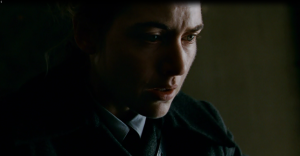
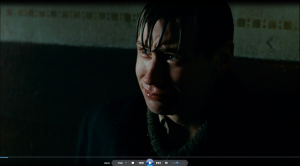
It is clear at the start that Hanna is the dominant character. She is older, more confident and appears to be in control of the situations. When she is speaking a low angle is used. The low angle supports her status as the dominant character. Whilst Peter is seen from a high angle, supporting his status as the weaker character or the character in need of help. Whilst the high and low angles support the status of these characters, they do not take the POV of each person but rather simply shows the dynamic between the two of them. In this scene, the viewer may not be sure about Hanna, her dominant position may lead to great care on her part or to something more sinister and it is not clear yet which it will be. On the other hand, the viewer can sympathise with Peter in his desperate position.
Toward the end of the movie, the roles are reversed. Hanna has spent a large part of her life in prison and has become a lonely, quiet woman with a terrible past that she lives with daily. Peter is the only person willing to have any sympathy for her.
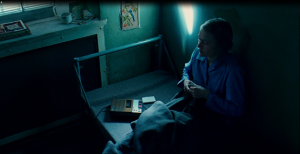
Shots of Hanna are taken from a high angle, making her appear somehow diminished, frail and hopeless. In the shot above, the lighting and the colour also add to the sense of misery she must feel. I had very mixed feelings about the viewers relationship with Hanna in this shot and wondered if it was intentional. At this point in the movie the viewer is aware of Hanna’s past as a German guard during the Second World War and the terrible things she had been involved with, but the viewer is also aware that she was convicted with evidence that was not true. The high angle of this shot clearly makes her look diminished, but it also creates a tension – should the viewer sympathize with her or not? The high angle is also adding to the sense of isolation or loneliness as we can see her very much alone in her cell with just her tape recorded stories as company.
The Avengers
In this movie, Loki is the bad guy and very early on in the movie steals the Tesseract, which is an infinity stone that gives him overwhelming power and, if he joins it with other infinity stones, the power the rule the universe (of course). Most of the scenes with Loki when he has the Tesseract are filmed from a low angle – giving the viewer the sense of the power Loki both feels and wields. Particularly in the second shot below, the tension is being built up and the question that viewer is asking is – what will he do next?
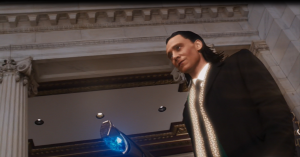
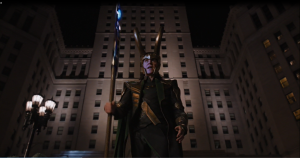
These shots clearly paint Loki as larger than life, full of confidence and in the second shot, very menacing and someone to very wary of. When the viewer then sees the reactions of the people that Loki is threatening (albeit in a very calm and reasonable voice), it is taken from a high angle and shows us Loki’s POV. It also shows the people lower than Loki and adds to the sense that they are both confused and afraid of him.
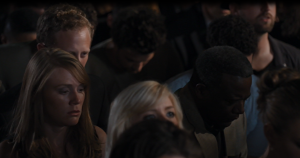
However, in the same movie – when the viewer is introduced to our hero, Captain America, he is also shot from a low angle. Cpt America is working out his frustration by punching a boxing bag (well, as it turns out a few punching bags). The shot is very low and the viewer is able to look up the length of his body as he hits the bag, with the lights and ceiling in the background.
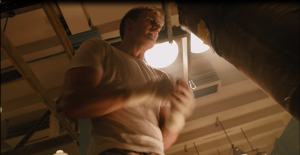
Clearly we are meant to understand that although this character may be struggling with inner demons, he is no wimp. The shot gives the feeling that this is a powerful, larger than life character. In this shot, the tension comes from the anticipation of whether this character will use his powerful body to do good or to just vent his anger. The light coloured clothing and brightness of the shot may be a clue that he will do the right thing.
The shot below, Natasha Romanov is being interrogated by a bunch of baddies. She has been tied to a chair that is perched directly in front of a wide chasm. A slight push and she and the chair will go over the edge. The canted angle of the shot shows her precarious position. The shot also adds to the building tension as it disorientates the viewer as to just how close she is to going over the edge.
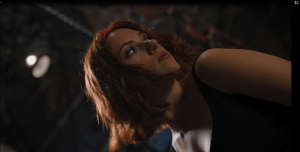
The Lord of the Rings – The Two Towers
This movie was a masterpiece of high and low angles – almost any of the scenes could have been used as examples.
High angles are often used to show the viewer the environment, where it is a battle scene or a landscape.
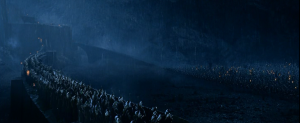
The shot of the orc army approaching the walls of Helms Deep is very high angle and we are able to see both the army on the wall looking down and the approaching orcs. This is a high angle shot that gives a huge amount of information about what is going on in the scene and also provides us with a sense of the scale of the threat. The viewer must surely wonder if it is at all possible for the people of Helms Deep to survive such a massive army.
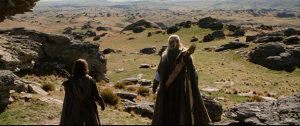
In the shot above, Aragorn and Legolas are surveying the landscape which appears never-ending. This high angle shot of the environment gives us a sense of scale and allows us to feel that the two characters are small by comparison to their challenge of moving through this territory quickly.
Low angle shots are also used to show how menacing the orcs are.
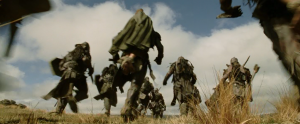
The shot in the above screen capture shows the orcs moving through the landscape to attack. Viewed from a very low angle, they appear threatening and violent which adds to the sense of fear that the viewer may feel. The very low angle (one could say it is at the grass line) can also give the sense that the viewer is hiding in the grass watching what is going on but not wanting to be seen.
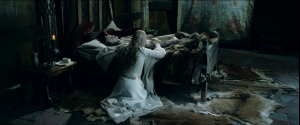
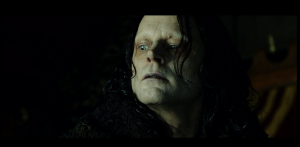
In the first shot above, the high angle is used for two purposes – firstly to show the distress of Eowyn who is mourning her brothers death. Secondly, to show the POV of Wormtongue who has just walked into the room and is looking at the deathbed scene from behind Eowyn. At this point in the movie, Wormtongue has the upper hand and his devious manouevres and deals with Saruman look to be working so he feels he can be cruel to Eowyn at the moment when she is in despair.
In the second shot, we have a low angle view of Wormtongue as he looks down on the scene, yet again reinforcing his strong position. This view, looking up at him, makes the viewer feel even more repulsed by him as he looks grotesque even whilst he from time-to-time smiles. This high angle then low angle switching also creates a sense of foreboding and that something evil is about to be revealed.
I had to include two other angles from Lord of the Rings – Two Towers. The shot below is of Saruman (the good guy turned evil) as he works his crystal ball. In this shot he is all powerful but clearly evil. The low angle shot does a perfect job of making him a very intimidating figure for the audience and sets the scene for the destruction and mayhem that he will later command.
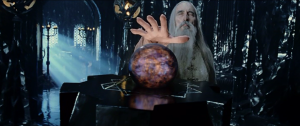
The other shot that is worth considering is the bird’s eye view of Aragorn as he floats on his back down a river and comes to rest on the banks of the at river. It is unclear where he is dead or alive until later when there is a close up of his face and he is breathing.
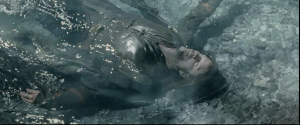
The high angle bird’s eye view (and a canted angle for some of the shot) is interesting because it disorientates the viewer and helps to give the unbalanced feeling of floating on water. However, the main effect of this very high angle is to give a view that we don’t encounter in everyday life. In the Grammar of the Shot, Bowen describes these types of angles as having an unnatural vantage point which ‘can create the feeling of being observed by otherworldly entities (ghosts, angels, aliens, etc.)’ (Bowen:2013:58). Very shortly after this shot, there is a cut to the elf Arwen, who appears to be aware of Aragorn’s fate and is speaking to him to keep him alive. Clearly this is an otherworldly encounter and it could be understood that the bird’s eye view was what of Arwen.
Out of Africa
This shot is a high angle from Out of Africa. It is also a POV shot that at the same time gives a very clear indicator of the roles and status of the two different characters. In the shot, Karen is sitting on her horse looking down at the farm manager. She is questioning him about some of the farm practices.
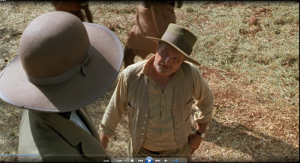
There is no doubt that Karen is in a position of power and will make the decisions. The angle is higher that an over-the-shoulder shot would normally be, consequently, the farm manager looks up to Karen to answer her questions and appears subservient to her.
Mission Impossible – Rogue Nation
Finding canted shots was far more difficult. In the shot below, Ethan Hawke has been tied to some kind of post. What the viewer does not realize at this point, is that Ethan is standing upright because the odd angle disorientates the viewer and gives the impression that he might be lying on the ground. The canted angle does an excellent job of also showing Ethan’s disorientation as he regains consciousness. The shot slowly rights itself as Ethan becomes more aware of his situation.
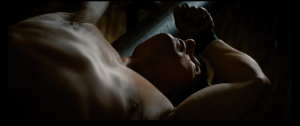
Bibliography:
Bowen, Christopher J., Thompson Roy. (2013) Grammar of the Shot. (Third Edition.) Burlington: Focal Press.
Images:
The Reader [feature film – selected images] Dir. Stephen Daldry. Weinstein Company/Mirage Enterprises. USA/Germany. 2008. 124 min.
The Avengers [feature film – selected images] Dir. Joss Whedon. Marvel Pictures/Paramount Pictures. USA. 2012. 143 min.
Lord of the Rings. The Two Towers. [feature film – selected images] Dir. Peter Jackson. New Line Cinema/Wingnut Films. USA/New Zealand. 2002. 179 min.
Out of Africa [feature film – selected images] Dir. Sydney Pollack. Universal Picures/Mirage Enterprises. USA. 1985. 161 min.
Mission Impossible. Rogue Nation [feature film – selected images] Dir. Christopher McQuarrie. Paramount Pictures/Skydance Productions. USA. 2015. 131 min.
